Tree leaves as supplementary feed for Ruminant Livestock
Feed and fodder availability among Asian countries is not sufficient to meet even dry matter requirement of growing ruminant population, there is need to explore new feed resources which do not compete with human feed chain (Raghuvansi et al., 2007). Tree forages form an integral part of ruminant feeds and use of tree forages as components of diets is a widespread practice in many countries. Fodder tree leaves are an alternative source of livestock feeding and tree leaves have the potential for alleviating some of the feed shortages and nutritional deficiencies for small ruminant and important component of goats and sheep diets (Kamalak et al., 2004). Fodder trees are an important source of supplementary protein, vitamins and minerals in developing countries (Baumer, 1992). Tree fodders are nutritious like leguminous fodder crop (Akram et al., 1990). Trees leaves play an important role in the nutrition of grazing animals in area where few or no alternatives are available (Meuret et al., 1990). Trees rages used as protein and energy sources for small ruminant (Singh et al., 1989) because the secondary plant compounds (Tannins) present in tree leaves, enables the ruminants to receive higher levels of dietary protein at post rumen for digestion and absorption (Leng, 1997). The use of multipurpose trees has been advocated in the tropics for several reasons. These include: supply of fodder to livestock; wind breaks; providing protection and supplying nutrients to the soil and therefore to plants; supplying fuel for cooking and heating; acting as live fences; and providing shade to both man and livestock.
When we talk of productivity of livestock, it all somehow depends on the fodder that they feed upon. There are various options available in the market to take care of your livestock’ diet, but sometimes we just hope if the expenses could be minimized. Well, that is totally perfect as long as your cattle gets the perfect nutrition and have a healthy diet. In this section, AW would try to focus on such options.
Leguminous fodder crops are regarded as the best cattle feed as they are rich in protein, carotene and calcium contents. They are nutritious and palatable and can be used for formulating cheap rations by replacing concentrates. Amongst the various types of leguminous fodder available, Cowpea and cluster beans (guar) are the most common Kharif leguminous crops. They contain 2.3% digestible crude protein (DCP) and 10%, total digestible nutrients (TDN). These crops yield about 100 q/acre.
Apart from it, there is Non-leguminous fodder. The nutritive value of these crops depends on the time and stage of their harvesting. Their flowering stage is supposed to be the richest in nutrient contents. Jowar, maize and sudangrass are most common kharif fodder crops. They contain 0.5-1 % DCP and 11.15% TDN (maize, however, has 1% DCP and 17% TDN). Their yield ranges from 100-200 q/acre.
Oat and barley are common Rabi fodder crops. Oat is excellent for the milch cattle and has 2% DCP and 17% TDN. Napier grass and guinea grass are perennial fodder crops.
Tree leaves are usually used for feeding sheep and goats and sometimes are fed to cattle during fodder crisis. These are also suitable for use as maintenance ration for livestock. The young leaves have a fairly high content of crude protein and less crude fibre comparatively. The tree leaves and shrubs are generally rich in calcium but poor in phosphorus.
Silage is a fermented feed which is made by storing green forages having a high moisture content, in the pits under air-tight conditions. In the absence of air, the forages undergo certain physical and chemical changes. The entire process requires two to three weeks for getting converted into silage.
Different Tree Leaves with Nutrition Chart
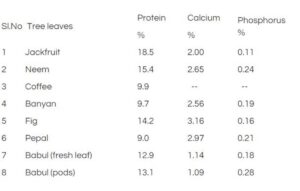
The most commonly used silage crops are maize, sorghum, sudan grass, bajra, and napier grass. But maize and sorghum are supposed to be the best crops for silage making. The, leguminous fodder crops like lucerne, berseem and cowpea are not suitable for silage making.
Root crops and kernels
Root crops have a high moisture content (70 to 90%) and low crude fibre content (5 to 12%). Roots are generally low in crude protein content. Carrot is rich in carotene content and increases the vitamin-A value of the milk. Therefore, it is fed to the milch animals during the winter season.
Tuber crops are little different from the root crops as they contain high amount of starch. They have higher dry matter and lower crude fibre contents than the root crops and are thus suitable for feeding to pigs and poultry. Examples of tubers are sweet potato, potato and roots of tapioca.
The seed kernels of fruits such as mango and jamurn are not utilized and are allowed to go waste. These kernels contain enough nutrients for keeping the animal healthy and hence can be used for feeding the animals especially during scarcity of fodder.
Large varieties of plant materials which are conventionally not included in the feeds for livestock are used for feeding of cattle and other ruminants during periods of scarcity. Some varieties of tree leaves are conventional feeds for sheep and goats. Certain varieties are also fed to cattle and buffaloes. Leaves of different species have different nutritional characteristics. In general, in the early stages of growth the leaves contain fairly high percentage of crude protein and comparatively low fibre content. As the vegetation advances in age, there is progressive decrease in the protein content and increase in the crude fibre. Tree leaves are generally rich in calcium, but have low phosphorus. The ratio of calcium and phosphorus is generally wide. Due to presence of tannic acid, the digestibility of protein in the leaves is low.
- Ardu leaves
- Bamboo leaves
- Ber leaves
- Bhimal
- Kachnar
- Mulberry leaves
- Neem
- Pipal leaves
- Robinia
- Tapioca leaves
Ardu leaves
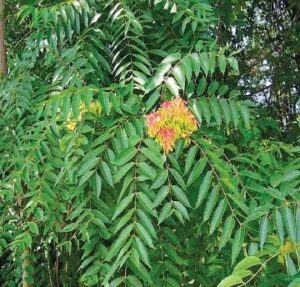
Ardu leaves (Ailanthus excelsa Roxb)
Local name: Ardu
Ailanthus excelsa Roxb belongs to the genus Ailanthus, in which two other species A. grandis and A. grandulosa are also found in India. All these species grow into enormous trees and a full grown tree gives 6-7 quintals of edible leaves twice a year.
Nutritive value
Crude protein and total digestible nutrients contents are 19 and 64%, respectively. Acid detergent fibre and neutral detergent fibre are 42 and 48%, respectively. Ardu leaves regarded as a good fodder by farmers. Mature leaves highly palatable and nutritious, usually fed to sheep and goats. Adult animals can be maintained on ardu leaves.
Bamboo leaves
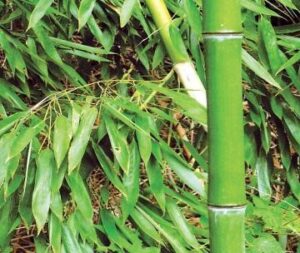
Bamboo leaves (Dendrocalamus strictus)
Local name: Bamboo
Bamboo trees grow in large parts of India. Large quantities of leaves become available during harvesting for paper manufacture. It is estimated that about 90-150 tonnes of leaves can be obtained from one hectare of bamboo forests.
Nutritive value
Bamboo leaves are rich in protein. The leaves in tender stages are relished by the animals and can form a part of the ration. Several studies shown that bamboo leaves are important source of roughage for feeding of livestock.
Ber leaves
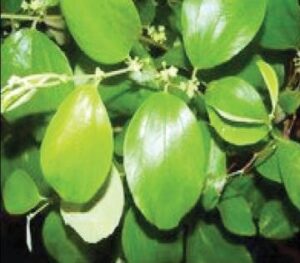
Ber leaves (Zizyphus jujuba)
Local name: Beri
Zizyphus jujuba is a commonly grown shrub, whose leaves are used as a conventional fodder for sheep and goats. In arid zones, it is an important fodder for these two species of animals. Ground leaves used in combinations with other feeds in dry season in Rajasthan. Entire shrub can be cut, leaves allowed to dry and beaten off with sticks. Dried product called pala (a generic term for dried leaves collected as livestock feed) and yielding at 1.0-1.6 kg dry matter per tree.
Nutritive value
In a comparative study on the palatability of different varieties of tree leaves; it was observed that beri leaves are comparatively more palatable than pipal or pakar leaves. The beri leaves have high crude protein content (18.6%) but the digestibility coefficient is only 36%.
Bhimal
Bhimal (Grewia optiva, Grewia oppositifolia)
Local name: Biul
Bhimal tree grows from plains to a height of 2000 metre. It is most commonly grown in the mountains region. It gives about 10-20 kg of green leaves per year per plant. It has been successively adopted in plains (Mathura and Izatnagar). It can be propagated both by seeds and vegetative cuttings.
Nutritive value
Bhimal leaves contain about 20-23% crude protein. The digestibility is very high (about
75%). There is practically no tannin in its leaves. It is commonly used as a supplemental feed for cattle, sheep, goats, etc. in the Kumaon and Himachal regions of India.
Kachnar
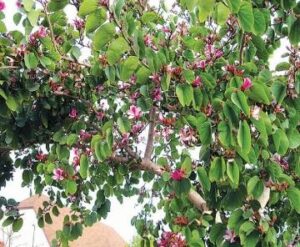
Kachnar (Bauhinia variegata)
Local name: Kachnar
Kachnar is very common fodder tree cultivated in India. The flower buds are used as vegetable. It is generally propagated by seeds.
Nutritive value
Kachnar is palatable to cattle, sheep, goats, etc. Leaves contain about 7.0% DCP, 1.5 Mcal of ME per kg dry matter. The tannin content is about 1.5%.
Mulberry leaves
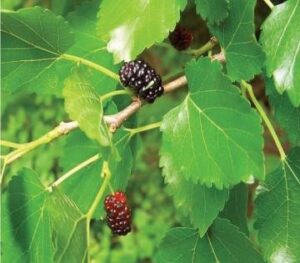
Mulberry leaves (Morus alba)
Local name: Kalambi
Mulberry tree is grown in the sub-Himalayan track up to 1500 m.
Nutritive value
The leaves are highly palatable. The left over leaves and stalks contain 11.4% crude protein, 2.7% ether extract and 3.4% crude fibre. These are highly palatable and the digestible crude protein is 7.8% and total digestible nutrients are 48.4%.
Neem
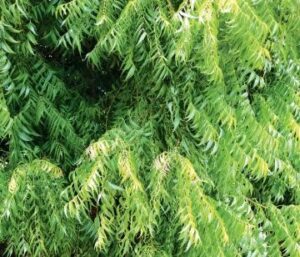
Neem (Azadirachta indica)
Local name: Neem
Neem trees grow all over India. The plant remains green throughout the year and is drought resistant. Large quantities of leaves become available if judiciously collected. Neem is a large and evergreen tree with edible fruits and aromatic leaves found throughout southern Asia. A mature tree can produce 350 kg of leaves a year, which may be used for feeding cattle during famines.
Nutritive value
The neem leaves are not relished by the animals. Buffaloes consume about four to six kilogram. The nutritive value is 6.19% DCP and 50% TDN. After the oil has been pressed from the seeds, the cake is used as fertilizer, but it can also be used as feed. Up to 10% neem cake may be included in concentrates for cattle and up to 5% for poultry. The oilcake has a very bitter taste. Leaves and cakes are used as anthelmintic for goats and is said to give healthy looking animals when fed.
Deleterious factor
The terpenoids azadirachtin and limonin impart a bitter taste and the leaves of A. indica are therefore not relished by cattle.
Pipal leaves
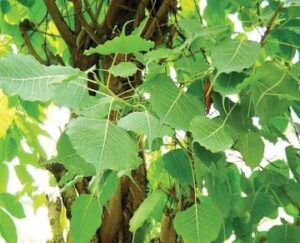
Pipal leaves (Ficus religiosa)
Local name: Pipal tree
Pipal trees grow throughout India. The trees remain green throughout the year. Considerable research has been conducted on the use of pipal leaves as livestock feed.
Nutritive value
The palatability and nutritive value of pipal leaves is not very good. Leaves when fed alone could form a maintenance ration. On an average, the leaves contain 5.47% DCP, and 39.22% TDN. The DCP content is fairly high as compared to conventional fodders. The TDN value is lower as compared to poor type roughages. Studies revealed that various nutrients in the leaves varied during different months and seasons. The leaves along with other sources of TDN could form a ration during scarcity periods.
Robinia
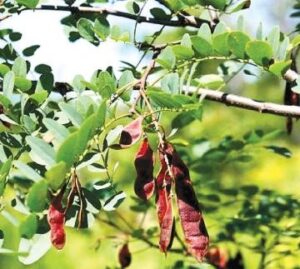
Robinia (Robinia pseudoacacia)
Local name: Robinia
Robinia is very good fodder tree which yields about 15 kg of green leaves per year. It can be propagated by seeds.
Nutritive value
Due to presence of higher tannins (1.9%), the digestibility of crude protein is low (50%). It contains about 10% DCP and 1.5 Mcal of ME per kg of dry matter. It is a palatable fodder for the farm animals.
Tapioca leaves
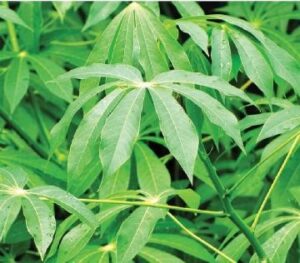
Tapioca leaves (Manihot esculenta)
Local name: Tapioca
Tapioca is a tuber crop extensively grown in Kerala State and parts of Tamil Nadu. Out of three species M. esculenta is most commonly cultivated in India. Annual production of tapioca in India is estimated at 4.5 million tonnes. At the time of harvest, generally the tuber is harvested and the leaves are thrown away.
Nutritive value
Tapioca leaves are a rich source of protein having a DCP value of 8.3% and TDN value of 45.5% of dry leaves. When fed to growing calves 2.27 kg of partially dried tapioca leaves could replace 0.68 kg of groundnut cake. Tapioca leaf meal also gives good results in feeding of lactating cows.
Deleterious factors
So far, tapioca leaves were not fed to cattle due to presence of hydrocyanic acid (HCN). The HCN content is the minimum when the plants are five months of age. The tapioca leaf meal contains 7.58 mg of HCN per 100 g of material. At an intake level of 0.5-0.8% of body weight, it does not bring about any adverse effect.

Uses of tree leaves as alternative feed resources for ruminant animals
Compiled & Shared by- Team, LITD (Livestock Institute of Training & Development)
Image-Courtesy-Google
Reference-On Request.

